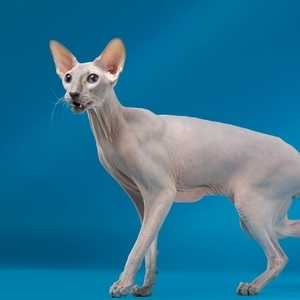
- Shortcut:
- PBD
- Group:
- Siamese
- Сategory:
- Primary
- Origin:
- Russia
The origin of the breed
Well, it's other name - Peterburg Sphynx, may already tell you where it comes from - the city of Saint Petersburg
The first hairless kittens, children of don sphynx Aphynogena Myth and a world champion tortie oriental shorthair Radma von Jagerhof were born in 90-s. Russian felinologists have attempted to create an elegant, refined hairless feline looking like oriental and modern siamese cats. Four peterbald kittens from the first litters, named Mandarin, Muscat, Nezhenka (Coddlegirl) and Nocturne, are considered to be the forebears of the breed.
The first WIP-standard was accepted in 1994 on a SFF-RFA conference. Then, TICA would be the first worldwide organization to admit the breed in 1997, with WCF catching up in 2003. Despite the novelty of the breed, it is already quite popular both in Europe and USA
Appearance
A tall, elegant cat with streamlined body, long legs and a tail that looks like a whip. The main distinctive feature is the sphynx baldness. There are three common types of peterbalds: Bald at birth - born with their eyes open and latex-like skin; Flock - these are born with balding head and thin and almost translucent coat, that thins out by the age of 2 months, and is completely lost by 2 years. Paws, muzzle and sometimes the tail may feel like velvet to the touch. The third type is the Brush - never completely losing their curvy hair, these cats may take part in competitions, but will rarely win any prizes. Brushpoints or simply Brush types used for selection, however, have better chances. One could also note that their breeding with completely bald peterbalds is permitted and encouraged. Extra warm body - a famous trait of don sphynx, is shared with peterbald.
Head: Medium size, elegant, wedge-shaped. Profile is almost straight, without any determined lines underlining space between front and rear part of the head. Nose is straight and long. Forehead is neither flat, nor arched. Sculls are high and flat. Muzzle forms a soft wedge, rather narrow, but has well determined whisker-pads, no pinch. Chin is rather firm and deep. Chin is much stronger by “flock" varieties.
Eyes: Almond form, big, slanted. Set rather wide. Color is green, olive or blue (by colorpoints).
Ears: Extra large, set wide, slightly flared. Outer lines of the ears follow the line of the wedge just below the flat sculls, making an impression of the equilateral triangle, angles of which correspond to the tips of the ears and the tip of the nose.
Neck: Long, elegant, muscular.
Torso: Medium size, tubular, refined, elegant, slender
Legs: Long, straight, rather slender, but strong. Musculature is well developed.
Paws: Oval, strong, bouncy. Paw pads are well developed. “Fingers" are long and flexible.
Tail: Long, whippy, resembles a horsewhip. Very straight: any defects are not allowed.
Coat: Only 2 varities are accepted for the shows: 100% hairless and brush-points. 100% hairless varieties have soft, warm, elastic skin that may range from «sticky» to silky «peach skin» . Because hairlessness may range from being 100% hairless to having almost imperceptible fine hairs. Brush-points have short fine hairs at the base of the ears, muzzle, feet, and tail. Torso, as well, may have thin hairs over it. Over «season» these hairs may vanish.
Color: Any color. Most valuable are: lilac, blue, chocolate, cream and colorpoint. Bi-color variants are also possible, but rather rare.
Penalize: Short, rounded head; small ears, too high set; too much coat; weak chin
Disqualification on shows: Over/underbite more than 2mm, tail deformations, inversion of the eye lid.
Disqualification for all breeds: Amputated claws, cryptorchism, deafness. Any bone deformation in the head, body, limbs.
Character traits and features
Peterbald is a very energetic, playful, talkative and loyal companion. Radiating with tenderness, they may often demand the same from their owner. They share space with other pets with no fuss, are generally smart and are easily trained. Cold and empty spaces, however, are simply not their thing.
There is still not verified whether they are hypoallergenic due to lack of coat.
Maintenance and care
Just as all hairless cats are, Peterbalds are sensitive and vulnerable to cold, wind and humidity in the room. As such, you should make sure it's living space is warm enough and use special cat clothes when it's too cold. Their love to sunbathing may also harm their skin, thus you should try to keep them away from open sun. Peterbalds are no different from other hairless cats in terms they are prone to sweating, as follows, you would want to wipe them with damp cloth on daily basis, it is also normal to give them a soak in a warm bath with special cat shampoo every so often.
Nutrition choices
You should look at bigger portions, all sphynx cats have an unusual appetite due to their heat exchange quirks.
Note that only highest quality foods are accepted.
Selection and breeding
Allowed crossings
None
Breeds, derived or selected with Peterbalds
None
Alternative, unofficial and obsolete names:
Petersburg's Sphynx - official name in russian.
Unofficial and slang names:
Petric; Resident of St. Petersburg.
